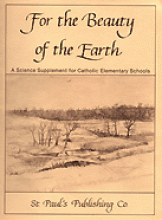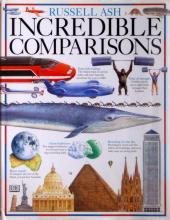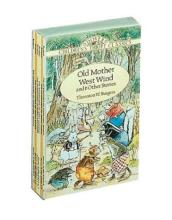General Science General Resource
For the Beauty of the Earth
Like many Catholic Home schooling families, providing a Catholic education was number one on the list of reasons my husband and I wanted to home school. In addition, we wanted a rigorous education, and one that emphasized the beauties of truth and love. Translating these goals into a curriculum is an on-going challenge. Sometimes the books that do a good job presenting a particular subject do it without the light of the Faith. Other times, books that are "solidly Catholic" are also unattractive and uninspiring. We have had to compromise in a lot of areas.
Two that we have not had to compromise in are science and history, and this is largely due to the Catholic school supplements produced by James Leek. These two are among the most excellent resources I have come across in home schooling. They include interesting material for study and careful explanation of an approach to education that is beautifully in keeping with our holy faith. In themselves, these explanations are worth reading and incorporating into your teaching.
In science, for example, Mr. Leek explains the integrating principles for a Catholic science education. Ultimately, our aim is to better know the Creator of everything. Science study also has remote ends: that we develop a respect for God's creation, and learn to contemplate and reflect on it, and that we exercise our minds to improve life and serve our fellow men. At the same time, science has its proximate and immediate ends: to learn how the world works and to take in sensory data of the physical reality around us.
These principles are very well realized in Leek's science supplement. For the Beauty of the Earth includes a textbook with literary selections organized around the common subject matter of science. The lyrics of the beautiful hymn from which this program draws its title provide the organizing system. In addition to "the beauty of the earth" (weather, metals, energy), we have chapters on "the glory of the skies" (stars, the sun), "hill and vale and tree and flower" "the mystic harmony linking sense to sound and sight" (insects, spiders, mammals), and "the joy of human love" (the senses, emotions, the will.)
The corresponding teacher's guide builds on the readings with questions and activities that take the student from considering the text, to observing the natural world, to admiring God's handiwork, and finally, to the religious analogy. An example to illustrate this progression would be the reading of "Phaeton and Apollo." After the selection is read, the student is asked a series of questions on the text: Who was Phaeton? Describe the court of the sun, etc. Next, students are asked to make some observations about the sun: Where does it rise and set? Does it actually move? What makes it appear to move? Then they are asked to consider the sun's role in life on our planet, and finally, to how the sun is like God, how its marvelous working points to the existence of God.
Questions and activities are broken into grade levels so that this program can be used throughout the elementary years. My first reaction when I looked at For the Beauty of the Earth was to think that this was a liberal arts soft-pedaling of the hard subject of science. But after I carefully read the author's introduction, I decided it could be so much more than that, and it more than met those expectations. We used it alternately with our regular science text, allowing the literary selections and projects to set the tone for our textbook's coverage. Along with enjoying some good stories, memorizing poems and scriptures, doing some fun projects (like building a humane mousetrap), I found that the sense of wonder created through the program carried into the rest of our textbook consideration of each topic. The course is cross-referenced with many of the most popular school science text series from the time it was published (early 1980s).
Out of print.
Incredible Comparisons
This picture book designed for "big kids" gives side-by-side comparisons according to length, height, area, life-span, speed, etc. of all kinds of things – animals, mountains, countries, modes of transportation, man-made structures and much more.
Segments of the book include: "On the Surface" (compares land-size of various countries, islands, different uses of land), "Into the Earth" (canyon depths, cave lengths and depths, etc.), "Going into Space" (compares power and speeds of rockets vs. airplanes, comet tail size comparison with various planets, etc.), "The Solar System" (compares planet sizes and distances, etc.), "Great Lengths" (compares lengths of airplanes, highways, major rivers, telecommunications cables, etc.). Other chapters cover animal speeds, land and water speeds, human population etc.
Does include some environmental and politically correct content. The segment on human population was much better than I expected, though. To give a sampling....
A population explosion has seen the number of people in the world more than triple since 1900 – from less than 2,000,000,000 to close to 6,000,000,000. Each day, enough people to fill the largest stadium in the modern world are added to the total. Thankfully, the world is a very big place. All the people in the world today could actually fit, standing shoulder to shoulder, on the small Indonesian island of Bali.
Old Mother West Wind and other stories
You are probably already familiar with the animal stories written by Thornton Burgess in the early 1900s. These go by titles such as "The Adventures of Johnny Chuck" and "Old Mother West Wind" and are sold by Dover Press for only $1. Each book tells about the life and adventures of various animals in such a way that the child easily learns about animal habitat and woodland lessons. In "Old Mother West Wind" the book starts off telling about her children, "The Merry Breezes," who carry scents of animals as they fly along ruffling (tickling) the fur of different animals. Later in the book we read about a bird who, one night, almost loses her eggs to a skunk without a stripe. Now we have an idea of why God gave skunks stripes. My daughter silently reads a chapter from these books each day and narrates them at dinner. These are written at the second grade level and contain just a few illustrations (line drawings).
Update April 2024: This particular boxed-set is no longer available, but the individual titles still are. Today, they run about $5 each, new.
The Universe in My Hands
The author, Mary Daly, explains her book and purposes in this overview.
I have long had a concern about the teaching of science. Most of the materials on the market are so scattered that I cannot think that children will have a clear concept of the meaning and value of science, nor any feeling that they can master its contents in any way. Indeed, most texts are centered on defining science as the product of a specific "method" of thought which has to do with hypotheses and experiments and records and reports. Boring ...and not at all the way Einstein or anybody else I know of actually operated.
Anyway, Natural Science was born in response to the command in Genesis: "Increase and multiply and fill the earth and subdue it." We cannot subdue – or exert stewardship – over what we do not understand. Science is about understanding the material world, our very exciting and beautiful home. In the spring of 2000, members of the local homeschool support group met for a week's science camp, and the next two years, followed up with weekly (almost weekly) science lessons.
The principle of organization is to understand the magnitudes – the sizes – of things and how their scale limits what they can be and do. A star, for example, cannot be much smaller than our sun – except by being fantastically dense – because the nature of stars requires that their gravity bring about their burning. A fly doesn't have enough gravity to burn that way. The planet Jupiter has almost enough.
With the curriculum organized around magnitudes, we had a principle of order for the relationships between all the disciplines of natural science, and as our body of knowledge increased, it was always interactive with previous information. Furthermore, there are only 45 magnitudes between the quark and the universe; this is a small enough number for any child to comprehend. He can finish the course feeling that he knows the universe – and why not? It is his home.
The science camp material is now available, suitable for a camp, or a semester, or up to a year for a small child. It includes:
1. A booklet about the 45 orders of magnitude – sorted by powers of ten – which form the universe as far as we know it. The booklet goes very slowly through the nine orders readily recognizable to ordinary sight – from a meter down to a tenth of a millimeter, and then up to ten kilometers. (It is really essential to use metric measure for this exercise. It is not assumed that the student already knows it.)
2. A set of 45 cardstock dividers, numbered and color-coded, one for each order of magnitude. These are to be placed in a notebook and materials collected illustrating objects at each magnitude are to be placed in each section by the student. These materials can be pasted pictures, drawings, reports, web printouts – whatever best represents what the student has considered at that order of magnitude, and according to his level of comprehension.
The color-coding of the dividers has to do with the fact that the smallest things we consider – electrons and protons, are studied in physics. The next smallest – molecules – are the study of chemistry. Then biology, with green dividers, and so forth.
I will be working to get the following year's lessons into print. They strengthen the magnitudes theme by taking various objects and explaining their characteristics, always in relationship to the orders of magnitude that shape them. Of course the lessons were printed at the time for my students, but not always in a well-finished form...
Copyrights 2002/2006
Consists of a booklet and a set of 45 cardstock dividers for a 3 ring binder.




